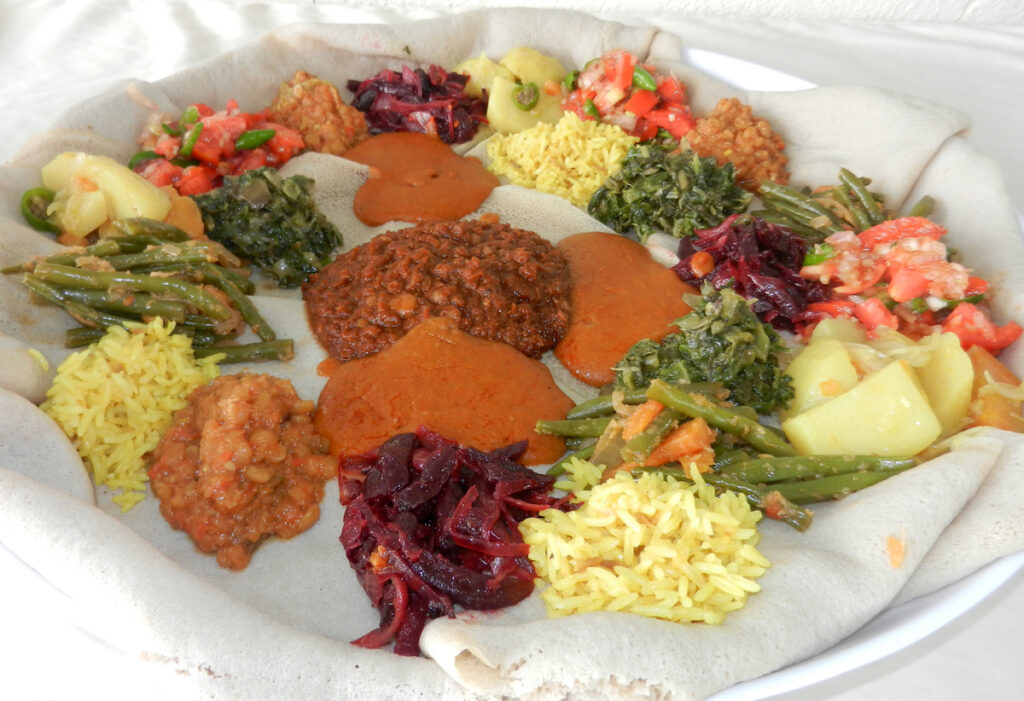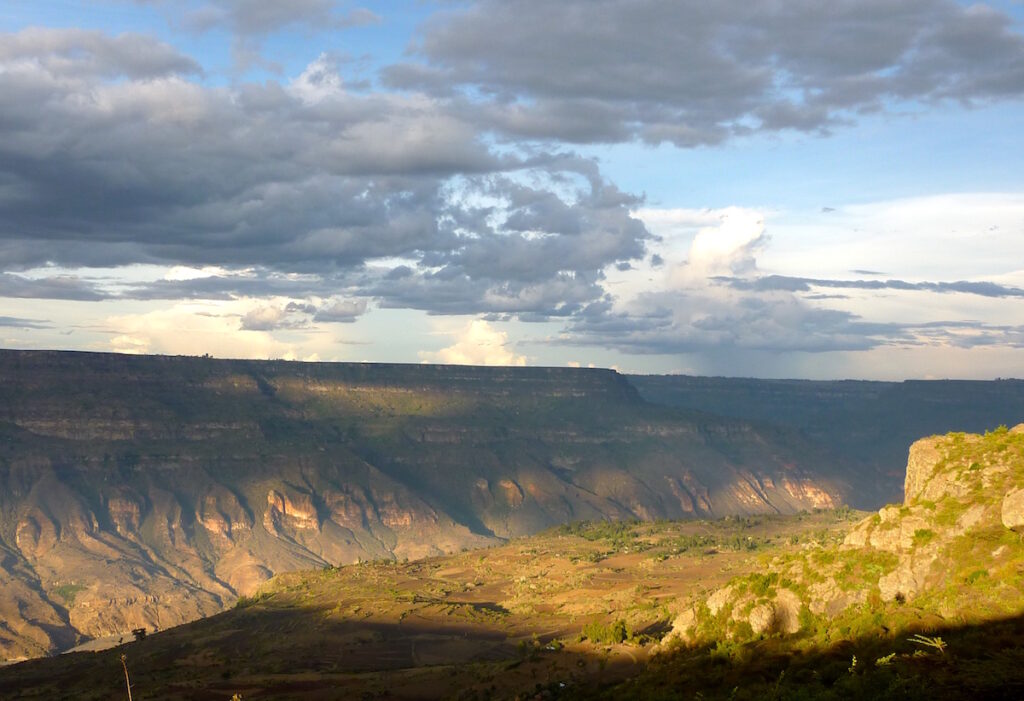
This week, we bring you the third installment of our Teaching Art Around the World Series. If you missed the previous articles, take some time to check out what it’s like to live and teach in Norway and Thailand.
Today, Helen Iglar, an elementary art teacher at the International Community School of Addis Ababa, shares a look into her school, her everyday life, and the culture in and around the capital city of Addis Ababa, Ethiopia. Helen lives there with her husband and daughter and has been there for the past seven years.
You will love reading about why kids are at school almost around the clock, the incredible food and coffee culture, and the rich and storied history of Ethiopia.

Helen’s Background
I’m originally from Ireland, although I was born in Uganda and raised in Kenya from the age of 6. I studied at Oxford University in England and had a winding road to becoming an art teacher from there. Over the next years, I taught science in Kenya, started my own bed linen company, and met my husband. We moved to Indonesia where we worked together before returning to the States to spend four years in Maryland. There, I stayed home with my infant daughter and enrolled in classes at a local arts center. Those classes inspired me to change my career direction and become an art teacher.
My family and I returned to teaching overseas in Tanzania for two years before landing in Addis Ababa, where we have been for the past seven years.
On Teaching in Ethiopia
Helen’s School
Our school offers instruction in English and serves the families of embassies, Non-Governmental Organizations (like the United Nations), and businesses in Ethiopia. A growing proportion of our student body is Ethiopian diaspora, who are returning to establish businesses in the region.
Required After School Activities
Typically I see students for 45-50 minutes every 4 days. I generally teach 5 blocks a day between 8am–3:20pm. I also run a voluntary Art Studio during the students’ lunch recess for students in 4th and 5th grade.

I am required to offer an art activity after school one day a week throughout the year. This year I offered iPad Art, Drawing Studio, and Zentangle Club as after school activities. Another responsibility I have is to provide a substantial art section for the annual elementary yearbook, showcasing student artwork.
The Reason for Long School Days
Our school day is long, beginning at 7:45am and we generally don’t get home until after 5pm. The school campus is large, green, well-equipped, inviting, and safe, so students tend to stay on campus doing organized or unstructured activities.

Many teachers offer activities for other teachers, such as Zumba, yoga, aerobics, choir, etc. There is also a gym, which teachers can use. The campus is also a hub of activity on weekends – it has a real sense of community and families enjoy the resources offered after school hours (library, running track, playing fields, playgrounds, and tennis courts).
Budgeting and Sourcing Supplies
We have to be extremely flexible, as frequently our supplies don’t show up in August, or ever! In fact, last year, part of our art order never came at all. This did affect our program somewhat, and we had to leave out projects we had hoped to do. To help out, we order lots of paper and paint, so we have leftover supplies to take us into the beginning of the next school year.
Due to shipping restrictions, there are also materials that we cannot have shipped, an example being aerosol cans, like spray paint, fixatives, and adhesives. We just have to do without them. We do have to be very organized and plan future projects up to a year in advance if we want to budget for and order the supplies.
The vast majority of our supplies come from the USA (I use Dick Blick for 90% of my order), but we purchase our fabric, yarn, wire, plaster, string, and wood locally.
School Lunches

Our school has a large cafeteria where the students and parents can eat, but many students bring their own lunch. The cafeteria offers two buffets: one western food and one Ethiopian food. The menus vary from day to day. Once a month there is “Food from Around the World” where the menu features dishes from a chosen country. My daughter only gets to eat cafeteria food once or twice a week, and always opts for the Ethiopian buffet.

Staff members also have the option of using the school canteen: a much more traditional Ethiopian restaurant, serving tasty food at excellent value. My favorite food dish is a vegetarian platter called “bayenetu.” It consists of a number of vegetable (potato, green beans, carrot, spinach) and lentil dishes with relishes of beetroot, chilies, and cottage cheese. These are all served in little piles on a large flat pancake type of bread called injera. I try to eat there once a week and enjoy sharing a large platter of food with my husband. This costs about $3 for the two of us!

The snack bar at my school offers delicious premium coffees throughout the day. We all enjoy meeting for a double macchiato during morning recess or after lunch.
Using a Different Calendar
The Ethiopian calendar is based on the Julian calendar, so it is 7 years behind the Gregorian calendar. This year is only 2009, so we are all a lot younger here! It can sometimes be interesting when we are referring to dates and have to use a special calendar that combines both systems.
 The time is also different here, with 7am being the first hour of the day, so it is called 1 o’clock. This is the same in the neighboring Swahili-speaking countries.
The time is also different here, with 7am being the first hour of the day, so it is called 1 o’clock. This is the same in the neighboring Swahili-speaking countries.
On Living in Ethiopia
The Neighborhood

Like many of the teachers, we live a short walk from the campus and have a small modern house with a little backyard. Many teachers also live in apartment buildings. The climate here is gorgeous, and many evenings we sit outside for drinks or meals alone or with friends. We have no heating or cooling system in our home or school – they’re simply open.

On weekends it is possible to get out of the city for hikes, camping or picnics. There are forested mountains around the city, which offer a pleasant escape from the traffic and noise. A little further away there is the rift valley and lakes, which are wonderful to visit on a long weekend. There is a long rainy season from June – October when it can get pretty cold. However, it is also sunny for most of the year, making it a very comfortable climate to live in.
Quality of Life

My family enjoys a quality life here in Addis Ababa, where traditional food, clothing, music, and dance are very prevalent in everyday life. It is politically relatively stable, and security is good.
We have rewarding work at the school, and our daughter receives a world class education in a beautiful environment. We enjoy a simple social life revolving around events with other families, and we travel extensively during school holidays. There is much less consumerism than in other countries, and children more often spend their leisure time doing sports or performance (theater and music) activities than in malls or cinemas.
Most people here–expats as well as Ethiopian families–are able to hire someone to help with housework or childcare. Some also employ a driver or a cook. We do hire a wonderful woman to help with housework (and she provided child care when our daughter was younger). This definitely adds to the quality of my leisure time, as I don’t have to clean our house when I get home from work.
The Importance of Coffee

This is also a real coffee culture, with excellent coffee grown, served, and enjoyed by all. Cafes abound in the cities, and one can get a good macchiato even at a highway gas station. Every feast or special occasion is marked with a traditional coffee ceremony, where the coffee is served strong, black, and sweet in tiny cups.
Culture and Religion

Ethiopia has an especially rich culture and history, which permeates all aspects of life here. It is a very religious society, with a majority being Orthodox Christians, and the rest being Muslim or from other Christian churches. The year revolves around the Orthodox calendar, and religious holidays are celebrated with lavish and colorful ceremonies.

For example, Timket is the celebration of the feast of Epiphany. It is marked by baptism in a holy river, and by carrying the true cross in processions through the cities from the churches to the river. You can see a photo from the celebration above.
Big City and Travel

Addis Ababa is the seat of the African Union and has the 3rd largest diplomatic community in the world, after New York City and Geneva. Consequently, it is a very cosmopolitan city with people from every country in the world.
It also is a huge airline hub, with Ethiopian Airways being Africa’s biggest and best airline. Therefore it is possible to fly just about anywhere from here with direct flights to Europe, Asia, the Middle East, and North and South America. In a given year we often travel out of Ethiopia 6 or 7 times.
On Teaching Abroad
I would absolutely recommend teaching abroad. In Ethiopia, there are excellent educational opportunities and school resources. I have a good salary and my benefits include travel, medical, housing, car loans, school fees, utilities, and professional development funds. Most importantly, my job satisfaction couldn’t be better.
Thank you so much, Helen!
Tell us, have you ever been to Ethiopia? How was your experience?
What were you surprised to learn from Helen?
Magazine articles and podcasts are opinions of professional education contributors and do not necessarily represent the position of the Art of Education University (AOEU) or its academic offerings. Contributors use terms in the way they are most often talked about in the scope of their educational experiences.





